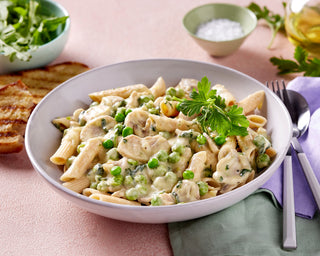
With a growing market, it's getting harder to differentiate between tasty-healthy, sort-of-healthy, and not-so-healthy meals when grabbing something on the go or adding to your cart. When facing these options, it's important to know what ingredients and food groups make up the dish.
That is why here at Dineamic we have developed a range of fresh ready to go meals, with the aim to make Australia healthier, one meal at a time. Our meals are packed with nutrition and flavour, using locally sourced ingredients that have been balanced by a team of nutritionists to meet the Australian Dietary Guidelines, with no hidden ingredients or preservatives to worry about, giving you every reason to feel good when heating and eating.
So our answer is YES, convenience food can be healthy you just have to find the right ones! Here's a few ingredients you should look for when choosing ready-made meals to allow you to make the best choice for your health, your taste buds and that grumbling tum!
Healthy Fats:
Healthy fats are linked to reducing heart disease and improving overall good health when eaten in moderation and in substitution of saturated fats. In small quantities, unsaturated fats such as Extra Virgin Olive Oil can be good for you. Not only does it help the food taste great, but it can also improve your good cholesterol.
Super Carbs:
Carbs are an essential nutrient group that our body needs for fuel. Like fats, carbs can be grouped in the good and the “bad” so it is important you choose a meal with a quality carbohydrate. These are carbohydrates that are high in fibre, keeping you fuller for longer. These include whole grains like quinoa, brown rice, lentils, legumes, sweet potato, pumpkin and so one.
Protein options:
When it comes to protein, we naturally think the more protein the better. This is not always the case as the average person - with a standard level of activity - generally only digests up to 25g of protein in a single meal. While it's true that animal sources pack a protein punch, 49% of the protein supply comes from non-meat sources. These include beans, quinoa, nuts and dairy, which also offer other nutritional benefits.
Vegetables:
There is no disputing the health benefits of eating five serves of vegetables a day. They’re nutrient powerhouses that are rich in vitamins, fibre, potassium, minerals and antioxidants that are repeatedly shown to play a role in reducing chronic diseases. One serve is about 75g (e.g. for cooked greens half a cup and for raw salad mixes 1 cup). These should be a staple in your meal choice, we think the more the merrier.
Salt:
Australians are consuming 10g of salt a day! That's 6g more than the recommended daily intake. But we shouldn't victimise salt, it gives us sodium, which is key to our fluid balance, nerve impulse and muscle relaxation. We just need to tackle overconsumption, we can do this by knowing what's in our food, reading the labels, avoiding heavily processed foods and indulging in more fruit and vegetables. Reading the ingredients list can help us decide what we want to eat so when we do sprinkle that pinch of salt, we don't have to feel guilty about it.
Preservatives:
A preservative prevents food from decaying, allowing us to keep products and produce for longer, decreasing food wastage and increasing food safety. It's a technique humans have been using for decades, with natural preservatives like salt, olive oil and vinegar. But there are definitely preservatives we should be cautious of and restrict in our diet. These are synthetic preservatives, which are not NATURAL and can commonly be labeled as additives to hide their chemical nature. A few common words to look out for are Nitrates, Sulphites, Butylated hydroxyanisole(BHA) and Butylated Hydroxytoluene (BHT), Sodium and potassium benzoate. A common rule we follow is, if you can't pronounce it don’t eat it. You can read more about preservatives here.




